32 Of The Toughest Holes In Golf
While the sport is primarily played for exercise and fun, we all like to challenge ourselves from time to time and it’s a genuine thrill to take on some of the toughest holes in golf


Around the world there are something like 40,000 golf courses of varying difficulty. Some are perfectly balanced with a few more gentle holes weaved into the magic, while others are unrelentingly tough from start to finish.
What creates the challenge can be length, the contours of the land, the wind, water close to or on the line of play, intrusive trees or narrow fairways, punishing bunkers, undulating greens, psychology… and very often a combination of all these.
Understandably, and quite rightly, all great courses have a hole or two that is designed to be particularly challenging, so here we take a look at some of the toughest holes in golf.
The Belfry (Brabazon) - Hole 18 - England

Situated on the outskirts of Birmingham, The Belfry has hosted the Ryder Cup on a record four occasions. If ever there was a fitting finale for this great exhibition of golf, this hole is it. It’s a long par 4, so to shorten your approach the drive must carry trees and water on the left. The safer line is the wide bunker at the end of the fairway leaving a longer second. The approach has to fly Moxhull Pond to a massive three-tier green which, depending on pin position, can mean a four or even five club difference. This is a classic finishing hole where anything can happen, and frequently does.
Cypress Point - Hole 16 - USA
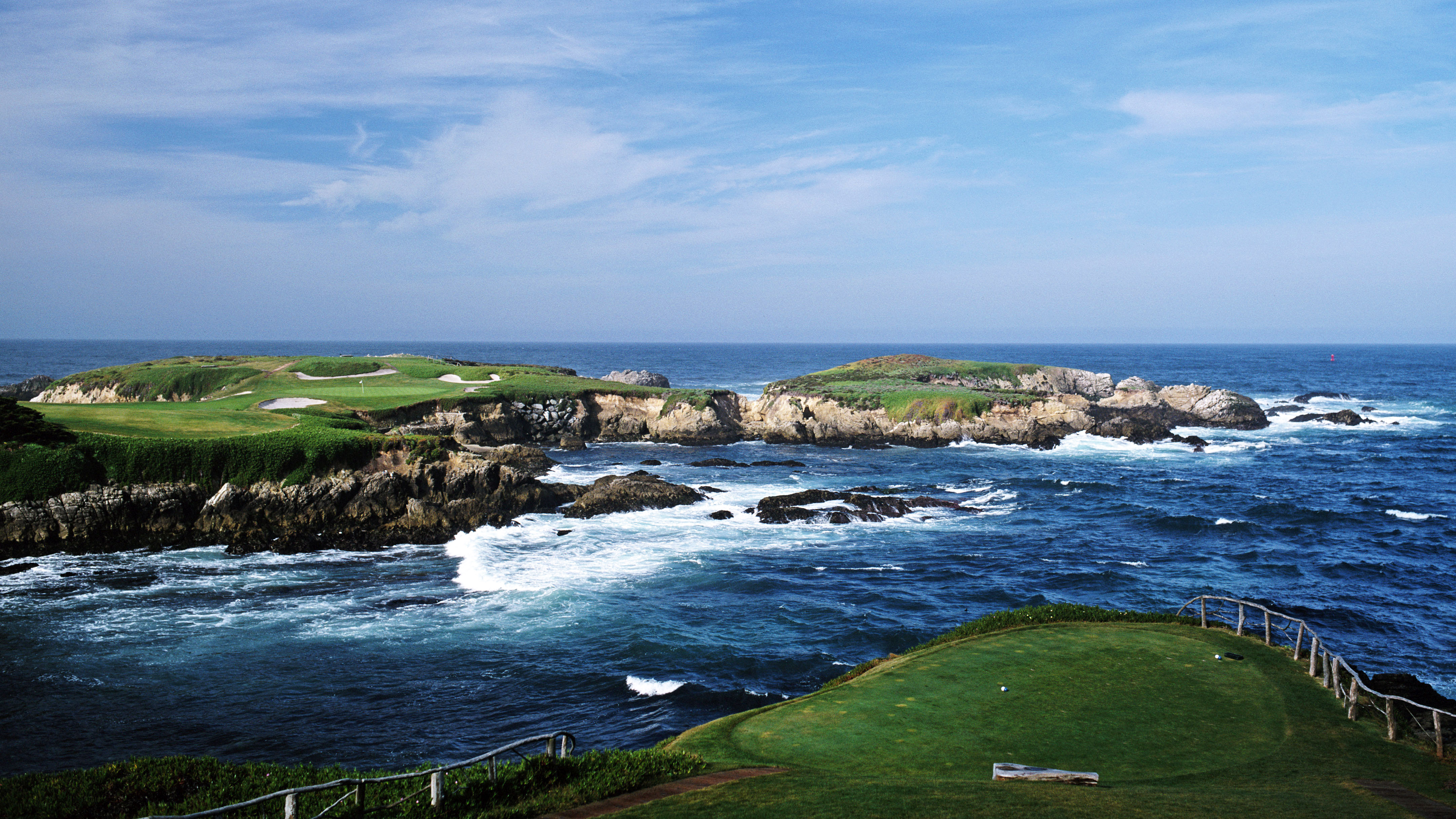
This exclusive club is home to a sensational course designed by Alister MacKenzie, designer of Augusta National. It nestles on the shoreline of the beautiful Monterey Peninsula, and the par-3 sixteenth will be instantly recognisable to millions of golf enthusiasts who have never even been near the course. It is a brute of a one-shotter, well over 200 yards, and played over, but frequently into, the Pacific Ocean. If you had to design a spectacular and breathtaking par 3, this would be it. Thankfully, there is a bail-out area short and left which means you can play it as a dogleg!
Vale do Lobo (Royal) - Hole 16 - Portugal

One of continental Europe’s very first golfing destinations, Vale do Lobo was originally designed by Henry Cotton. His work has since been split to create two excellent resort courses, the Ocean and the Royal, where water is a regular feature and the rolling fairways are flanked by pine and wild flowers. The Royal's sixteenth is as close as you get to the sea on any course in the Algarve. It is a thrilling and very photogenic hole played over the red sandstone cliffs where anything left will plummet to the beach.
Narashino - Hole 4 - Japan

Situated on the outskirts of Tokyo, Accordia Golf Narashino Country Club has 36 holes and is home to the Zozo Championship on the PGA Tour. The event was won in 2023 by former Open Champion, Collin Morikawa, and is played using nine holes from each of the King and the Queen courses. The fourth is a monster par 4 of 505 yards with water, trees and sand. The water will swallow anything left off the tee, and it is then channelled across the fairway to create a lake short and right of the uphill green. It was the 43rd hardest hole on the Tour in 2023.
Get the Golf Monthly Newsletter
Subscribe to the Golf Monthly newsletter to stay up to date with all the latest tour news, equipment news, reviews, head-to-heads and buyer’s guides from our team of experienced experts.
Merion (East) - Hole 18 - USA

When it comes to classic courses, Merion East is one of the all-time greats. It was designed by a 32 year-old amateur golfer who was a club member, and opened for play in 1912. 101 years later, this is where England’s Justin Rose captured his first Major, the US Open. The following year it was restored by Gil Hanse, and the closing hole provides a very fitting climax. It’s a long par 4 where ideally you drive over the brow of the hill before a shot up to a beautifully-sited green overlooked by the clubhouse. It was here in 1950 that Ben Hogan hit his famous 1-iron shot to the centre of the green which forced him into a play-off for the US Open, one which he would go on to win.
Trump International Golf Links - Hole 18 - Scotland

This fabulous Martin Hawtree design opened for play in 2012 and shows that you can defy logic and create an instant classic. It has earned a worldwide reputation for its superbly-manicured rollercoaster ride through quite spectacular dunes. Each hole is separate and memorable, and the par-5 closer from an elevated tee offers a thrilling but very difficult test that will keep you in your toes right to the very end. There are bunkers left, bunkers right… oh, and bunkers centre!
Bay Hill - Hole 18 - USA

Situated on land that was once an orange grove, this course is now a permanent tribute to its designer when it is used each Spring for the Arnold Palmer Invitational. The closing hole will scare the life out of anyone who tends to hit the ball to the right, as there is a lake that starts more than 100 yards short of the green, which itself is draped around the far end. When the pin is back-right, it is one of the most intimidating shots in golf, although perhaps not so for Tiger Woods who has won here no fewer than eight times.
Old Head Golf Links - Hole 16 - Ireland
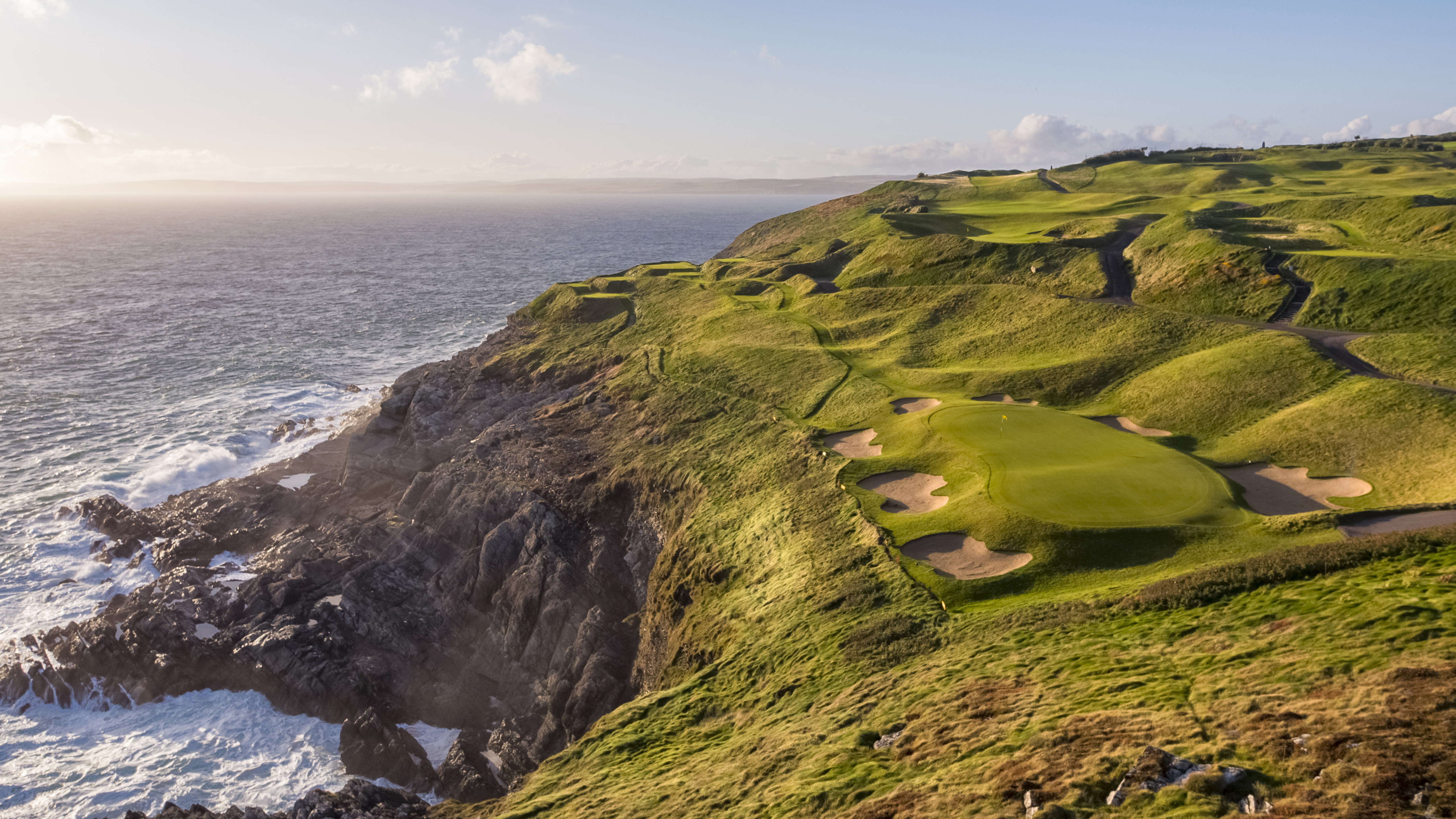
Opened for play in 1997, Old Head Golf Links is blessed with probably the most stunning location for a golf course anywhere in the UK & Ireland. The course and its amenities fit perfectly onto every available piece of navigable land on this spectacular peninsula in County Cork. The views from the edge of the towering cliffs are simply unbeatable, and we could probably choose one of several such holes in our toughest category. As it is, the fabulous par-3 sixteenth is 186 yards from the back, surrounded by sand and with the wild Atlantic Ocean beckoning on the right.
Yeovil (Newton) - Hole 7 - England

It’s good to hear about a one-off that you probably didn’t even know existed, so welcome to the 9-hole Newton Course at Yeovil Golf Club in Somerset. The seventh hole is a short par five where you have to play a completely blind second shot over a raised, disused railway line, the centre of which is some 170 yards short of the green. You then walk through the tunnel (pictured above from behind the green) that connects the two parts of the fairway, and hope to find your ball safely on the other side! Very big hitters who can also fade the ball may just fancy their chances of clearing the trouble with their drive.
Pebble Beach - Hole 8 - USA

Pebble Beach is a golfing paradise on California’s western seaboard between San Francisco and Los Angeles. The course itself is nothing short of spectacular with hole after hole of prime real estate hugging the undulating shoreline. It is a frequent host of the US Open, and accordingly has its fair share of testing holes including the magnificent par-4 eighth. Here, you drive to a generous fairway before a long second over the ocean which Jack Nicklaus has described as his favorite approach shot in all golf.
Royal Lytham & St Annes - Hole 17 - England

This is one of the most demanding and strategic links tests in the country and it has hosted the Open Championship eleven times. The penultimate hole is a long par 4 where the drive must avoid seven bunkers lining the landing area. A further six await short and left of the green and on its right-hand side, and there is a plaque back on the fairway that commemorates a famous shot by Bobby Jones in the first Open here back in 1926. He played onto the green from behind a dune and a sandy lie with a mashie-niblick, from 175 yards, a shot that eased him to a 2-stroke victory.
Real Valderrama - Hole 4 - Spain

Awarded its royal status in 2014, this notoriously difficult course consistently features very high up in the continental rankings. It was designed by Robert Trent Jones Senior and has hosted many professional tournaments including the dramatic 1997 Ryder Cup. The fairways are lined with trees, many of them cork oak, and the immaculate greens are unusually small. The bunkers are deep and filled with a coarse, grainy sand that is uniform throughout. The fourth hole is a beautiful par 5 that is protected by a pond and also a waterfall where it is all too easy to be distracted or to try and take on too much.
Riviera - Hole 18 - USA

This exclusive club in Los Angeles has hosted many top-level championships including the US and the US Senior Opens, the PGA Championship, and of course the Los Angeles Open. It is a green oasis completely surrounded by suburbia on the western side of the city, and it closes with a really tough par 4 with a blind drive played from way below the fairway. The green has a terrific amphitheater setting below the clubhouse which creates a stadium-style finish to any round.
Carnoustie (Championship) - Hole 18 - Scotland

The Championship Course at Carnoustie is one of the best and toughest links in the UK, a supreme test of golf and a links for the connoisseur that is distinguished by its superb, revetted bunkering. There are plenty of highlights including an amazing sting in the tail with the two closing par 4s where you must cross the Barry Burn no fewer than five times from the championship tees. From the back tee on the eighteenth, your drive must carry it twice and avoid bunkers on the right, before the approach crosses it again. If you want to know just how difficult it is, ask Jean Van de Velde whose seven in the final round of the 1999 Open sunk his Major ambitions.
Augusta National - Hole 12 - USA

This course has hosted more major championships than any other, and it has thrown up some very dramatic finishes over the years. But there is drama all the way on the back nine, and the short twelfth is renowned for its ability to confuse and deceive. Just 155 yards, Golden Bell is all about club selection, and of course holding your nerve. Rae’s Creek lines the front of what is a very shallow green that is also protected by three magnetic bunkers. In the 2023 Masters, it was ranked the toughest hole at Augusta against par.
Golf National (Albatros) - Hole 18 - France

Home to the French Open and host of the 2018 Ryder Cup, the Albatros is one of three courses at the home of the French Golf Federation just outside Paris. There are many water hazards that will challenge and entertain in equal measure, and it was designed with tournament play and drama very much in mind. The closing hole is a cracker; a long par 4 where the drive must avoid water lining the left hand side before crossing it to what is effectively an island green.
Thracian Cliffs - Hole 6 - Bulgaria

This endlessly exciting course will more than reward any effort made to get to its somewhat remote location on the edge of the Black Sea. It is a Gary Player design, and the opening holes run along the clifftops that line the shimmering water. These include the signature hole, the par-3 sixth which can stretch up to 230 yards for those so inclined. You play from a very elevated tee to a green perched way below on a promontory bordering the ocean. Beyond it, the next stop is northern Turkey, more than 200 miles away. If there are bucket-list courses, then this is a bucket-list hole.
Oak Hill (East) - Hole 6 - USA

This Donald Ross design dates back almost a century and is very tough but also very fair. It has been used for many important events such as the 1995 Ryder Cup, as well as the 2023 USPGA, following which Scottie Scheffler said, “Six is probably the hardest hole I’ve ever played.” It topped the stats for the hardest hole on the US Tour in 2023 playing at more than half a shot over par, and so has reasonable claims for being something of a brute! It’s a maximum-distance par 4 that doglegs slightly right with Allens Creek and marshland hugging the right. You then cross the creek, which then hugs the left side of the green with a large bunker on the right. Other than that, it’s quite straightforward!
Royal Birkdale - Hole 1 - England

Widely recognised as one of the toughest opening holes on the Open Championship roster, the first at Royal Birkdale is nonetheless completely fair. As, indeed, is the whole of this wonderful course. It was originally designed in the late 1890s by George Lowe before being raised to championship quality in the 1920s by Hawtree and Taylor. Their design philosophy was to route the holes though the dunes rather than over them, and the course sets out its stall perfectly with this demanding opener, a right to left dogleg with a pair of bunkers waiting hungrily on the corner.
Jumeirah Estates (Earth) - Hole 18 - United Arab Emirates

With more than 100 bunkers, twenty lakes and two meandering streams, the Earth Course at Jumeirah Golf Estates is the established home to the climax of the Race to Dubai, the DP World Tour Championship. Somewhat ironically, it was designed by one of LIV’s founding fathers, Greg Norman, known for his bold statements on the course and off it. He has described the final four holes as “the most challenging mile in golf”, and the eighteenth, a par 5, pretty much sums up risk and reward. Not heavily bunkered, there is a serpentine stream meandering up the fairway and right beside the green.
Cape Kidnappers - Hole 15 - New Zealand

This is a true, bucket list course; outstanding and aspirational, not easily accessible, pricey, and one that absolutely warrants that once-in-a-lifetime indulgence. It overlooks Hawkes Bay on the North Island of New Zealand, and is astonishingly attractive as well as a proper test of golf. Many consider the fifteenth, Pirate’s Plank, to be the signature hole. It can stretch to 650 yards from the back, but there are no bunkers until the green, and none are needed as there are perilous drop-offs either side. Simply sensational.
Royal Porthcawl - Hole 2 - Wales
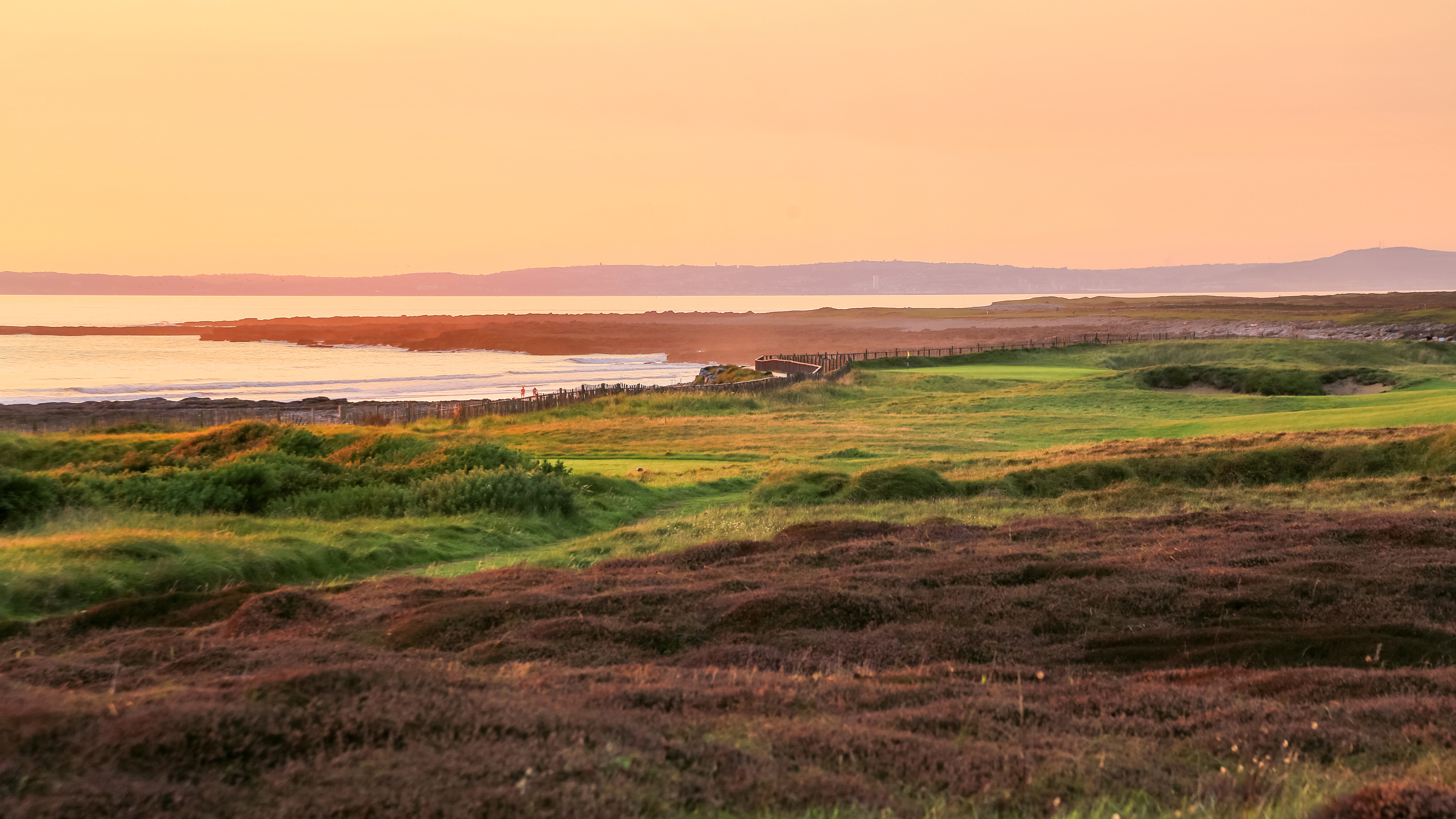
This is almost universally recognised as the finest course in the country, both for its strategic examination and for its brilliant coastal setting. There are frequent changes in direction and elevation, the latter rewarding the golfer with excellent sea views throughout. Protected by the wind and its very impressive bunkering, it is a delight from start to finish with far greater variety than most other seaside courses. Arguably the toughest hole is the par-4 second which calls for a long approach towards a green that is bordered to the left by the Wales Coastal Path, the beach and out of bounds.
DLF (Gary Player) - Hole 17 - India

Gary Player designs are extremely highly rated and have already made a significant impression worldwide. Here, just outside Delhi, he re-fashioned half of an existing Arnold Palmer design at the same time as adding nine new holes of his own. The course has hosted the Hero Indian Open since 2017, which was won by Marcel Siem (pictured playing the seventeenth) in 2023. This penultimate hole is a really tricky par 4; no great length but calling for a very elevated and blind approach up to a green the other side of vast quarry of inhospitable land.
Ba Na Hills - Hole 16 - Vietnam

This remarkable course works its way through an undulating and peaceful jungle-scape. It was designed by Ryder Cup skipper Luke Donald in 2016, and has won multiple awards including best new course in the world. It is packed with drama and fun. The back nine is the more hilly and even more photogenic, with superb, sweeping par 5s at 11 and 14, and one of the scariest par 3s in golf at the sixteenth. Played from a suitable elevation that shows off both its beauty and its beast, it is 217 yards from the championship tee down to an island green.
Legends - Hole 19 - South Africa
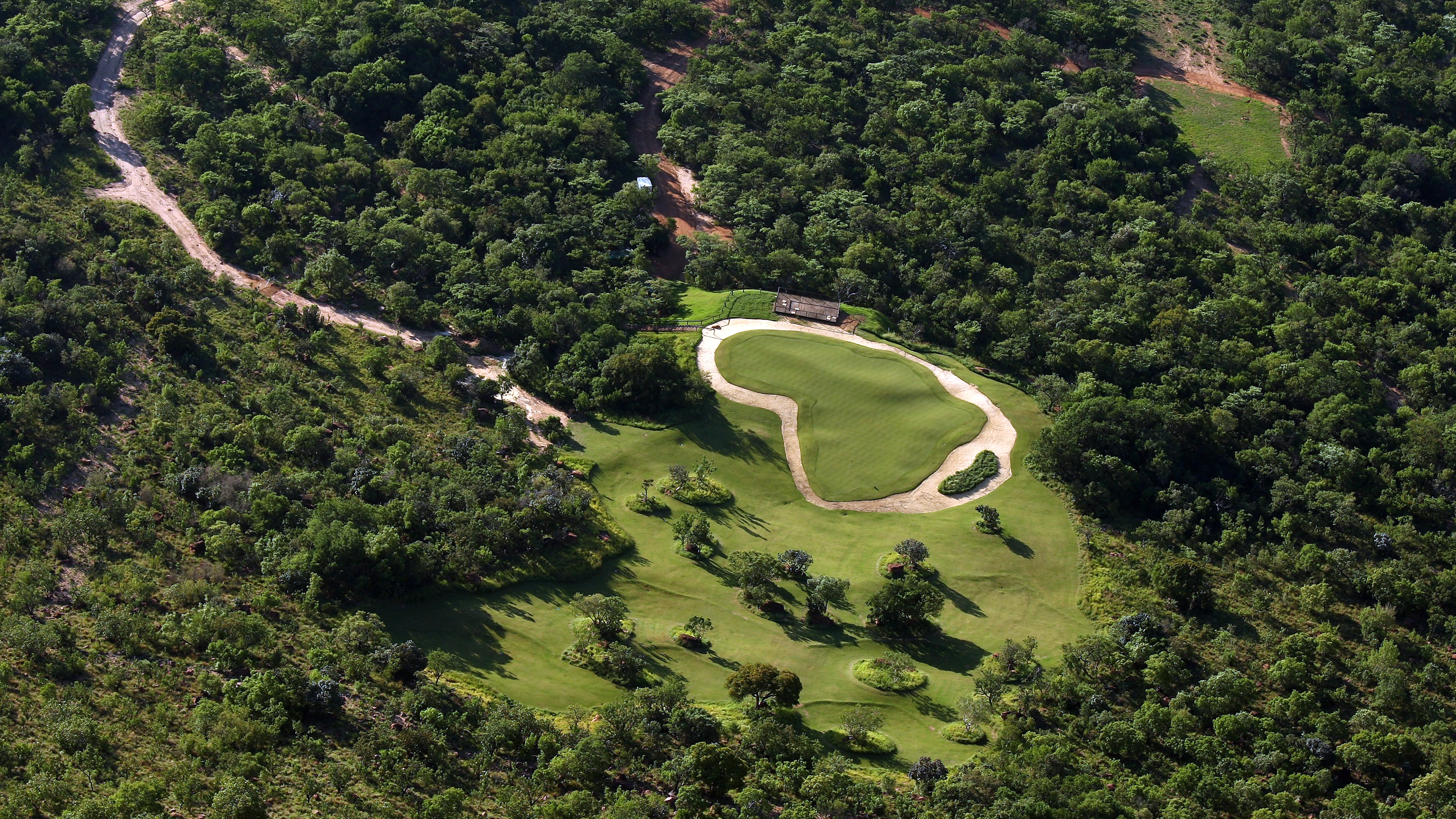
And now for something completely different! This will never be a part of your monthly medal, but is instead a complete one-off that we simply couldn’t ignore. It’s currently closed for renovations, but in theory, and supposedly in practice, it’s a par 3. It also happens to be the longest par 3 in the world… 395 yards… and only accessible by helicopter. The tee is actually a quarter-of-a-mile above the Africa-shaped green and it takes almost 30 seconds for the ball to land. Completely mad, but incredible fun.
Royal Troon (Old) - Hole 8 - Scotland

One of golf’s, and indeed life’s, greatest clichés is ‘short but sweet’. Here we make no apology as the eighth hole at Royal Troon is one of the game’s great par 3s. The lack of length is no guarantee of success on this classic hole, the shortest on the Open Championship roster. The tiny green is scarily narrow and surrounded by hungry bunkers, the catchment areas of which are magnified greatly by the natural contours of the land. Gene Sarazen holed in one here at the age of 71, while plenty of golfing heroes have run up big numbers.
Casa de Campo (Teeth of the Dog) - Hole 7 - Dominican Republic

The dramatic name of the course - Teeth of the Dog - begs your attention. It is derived from the jagged coral which lines the shore immediately adjacent to seven of the holes on this spectacular Pete Dye ocean-side design, including the magnificent par-3 seventh. From the back, this stretches to well over 200 yards with a tee shot all the way over the sparkling Caribbean Sea. A 100-yard waste bunker awaits anything short or left, and just to make things even tougher, there are four conventional traps lining the right.
Royal Portrush (Dunluce) - Hole 16 - Northern Ireland
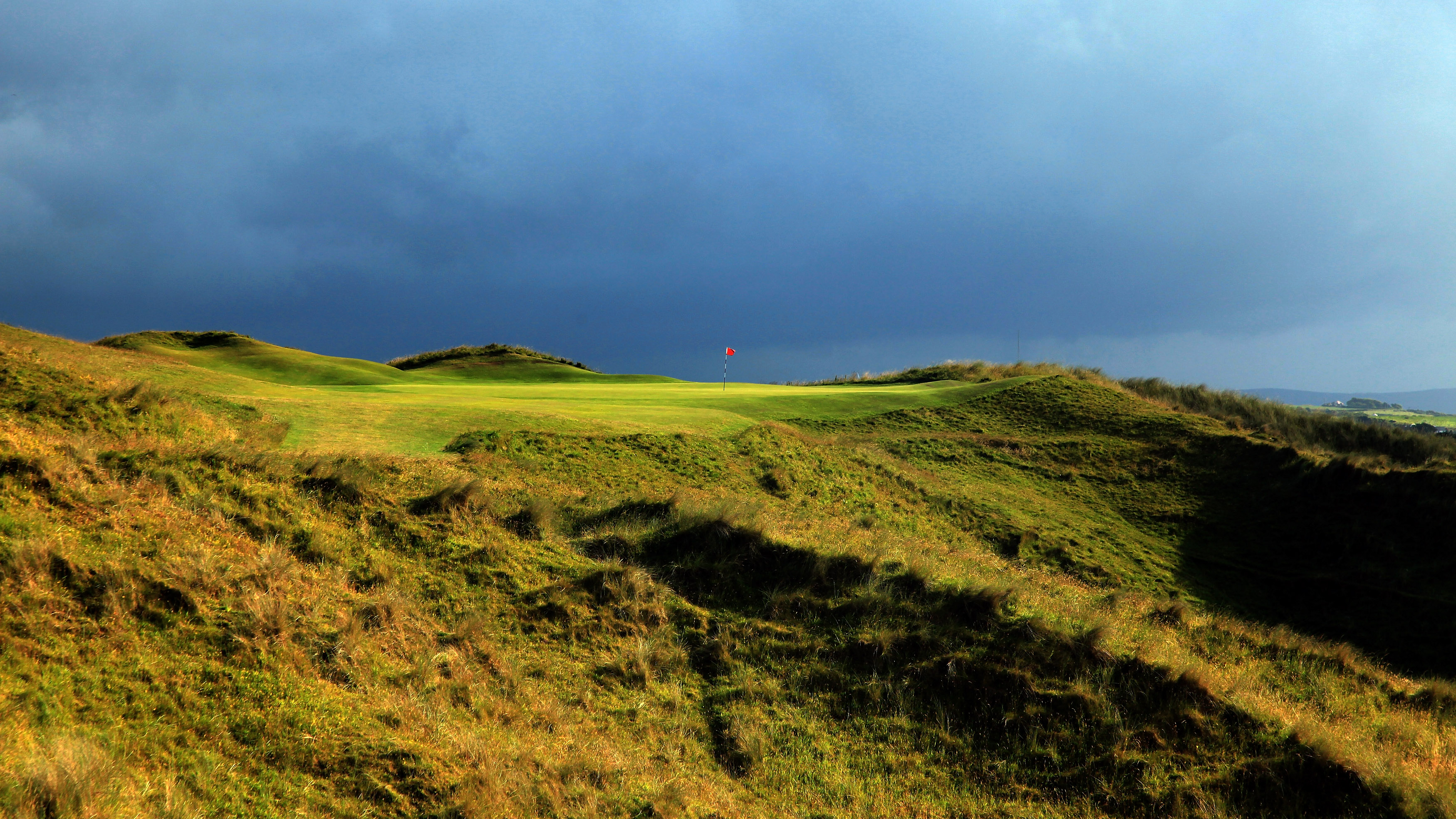
The Dunluce Course at Royal Portrush was seriously upgraded for the 2019 Open and is up there among the best links courses not just in the UK&I, but in the world. It was designed by the godfather of golf course design, Harry Colt, and even before the changes, there were plenty who felt it was a contender for the best course in the whole of Ireland. Its final par 3, the sixteenth, is super-tough. Calamity Corner can require just about any club in the bag as you attempt to fly the ball over a deep and unforgiving chasm. There are no manmade bunkers here, and none are needed.
Whistling Straits (Straits)- Hole 18 - USA

Pete Dye’s amazing creation at Whistling Straits has hosted the USPGA three times as well as the 2021 Ryder Cup. It is highly regarded for its extravagant and very abundant bunkering. The closing hole is a spectacular monster of a par 4 - 520 yards from the tips - with both the drive and the second (and let’s be honest, for most of us the third), played over deep, impenetrable jungle and a million bunkers. It is as beautiful as it is demanding, and apologies for this, but it’s official name is Dyeabolical!
Royal Melbourne (West) - Hole 6 - Australia

While it is usually a composite course with the East that is used for big events, it is the West Course at Royal Melbourne that regularly tops the various charts of Australian golf. It was designed by Alister MacKenzie, and the sixth is a classic example of a strategic two-shotter with the bunkering perfectly positioned on the corner of the dogleg. Big hitters will attempt to drive over the sand leading the way to a much shorter approach. This is the view looking back from behind the sloping green.
St Andrews (Old Course) - Hole 17 - Scotland

The Road Hole on the Old Course at St Andrews is one of the most famous, most revered and indeed most feared holes in golf. If you manage to cut the corner with your drive over the old railway sheds in the grounds of the Old Course Hotel, you will shorten the approach. But the real fun is only just beginning! Protecting the entrance to the green is the avaricious Road Hole Bunker where anything can and often does happen, while a touch too long and you will end up on the road itself or up against the stone wall beyond.
TPC Sawgrass (Stadium) - Hole 17 - USA

Although his courses are always fun and extremely visual, Pete Dye’s individual hole designs feature regularly in any list of tough holes. This tiddler of a par 3 is instantly recognisable and dramatic, and causes great anxiety and televisual delight each year at The Players’ Championship. At 137 yards it is barely a club more than the Postage Stamp at Troon, but it could hardly be more different. A one-day survey of regular visitors in January 2023 found that more than half of all shots played found the water, and every group to play had at least one ball disappear into the lake.

Rob has been playing golf for over 45 years and been a contributing editor for Golf Monthly since 2012. He specialises in course reviews and travel, and has played over 1,250 courses in almost 50 countries. In 2021, he played all 21 courses in East Lothian in 13 days. Last year, his tally was 78, exactly half of them for the first time. One of Rob's primary roles is helping to prepare the Top 100 Courses of the UK&I, of which he has played all, as well as the Next 100 where he is missing two in Scotland and two in Ireland. He has been a member of Tandridge for over 30 years where his handicap hovers around 15. You can contact him at r.smith896@btinternet.com.
-
 RBC Heritage Prize Money Payout 2025
RBC Heritage Prize Money Payout 2025Scottie Scheffler defends his title at Harbour Town in the latest of the PGA Tour’s signature events
By Mike Hall Published
-
 The Last Time Rory McIlroy Won A Major (Prior To The 2025 Masters)....
The Last Time Rory McIlroy Won A Major (Prior To The 2025 Masters)....We wind the clock back to the year 2014, when Rory McIlroy was the heir-apparent to Tiger Woods
By Michael Weston Published
-
 32 Of The Best Links Courses In The World
32 Of The Best Links Courses In The WorldLinks is the sport we love at its most elemental, the roots and foundation of the game. Here, we take an enthusiastic look at some of the best links courses in the world
By Rob Smith Published
-
 32 Of The Most Beautiful Golf Courses
32 Of The Most Beautiful Golf CoursesFrom stunning clifftops to tropical gardens, and from rolling fields to rugged coastlines, golf is blessed with more outstandingly attractive arenas than any other sport
By Rob Smith Published
-
 32 Of The Best Finishing Holes In Golf
32 Of The Best Finishing Holes In GolfNot every great golf course has the perfect closing hole, and here we take a look at plenty that do as well as a few that you may not yet know
By Rob Smith Published